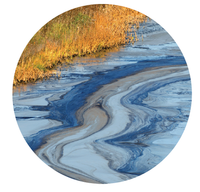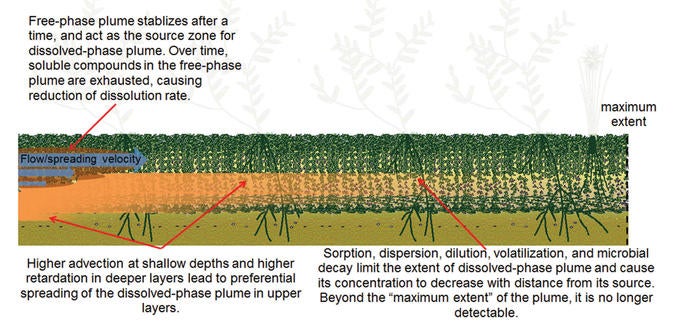 Given the extent of hydrocarbon resource development in the boreal regions of Canada and its transport by rail and pipelines, there is a high potential for spills and contamination of peatlands, which comprise a large proportion of the land surface. While significant research has been undertaken on the fate and transport of petroleum hydrocarbons in mineral soils and aquifers, very little research has been undertaken on their fate and transport in peat and peatlands.
Given the extent of hydrocarbon resource development in the boreal regions of Canada and its transport by rail and pipelines, there is a high potential for spills and contamination of peatlands, which comprise a large proportion of the land surface. While significant research has been undertaken on the fate and transport of petroleum hydrocarbons in mineral soils and aquifers, very little research has been undertaken on their fate and transport in peat and peatlands.
Boreal peatlands include bogs, fens, and swamps, each of which have different hydrological, hydrogeological, botanical, chemical, and biogeochemical characteristics. These can cause distinct differences in the distribution and mobility of non-aqueous phase liquids (NAPLs) and solutes in groundwater systems, compared to their expected behaviour in mineral soil systems.
In this paper, Gharedaghloo and Price (2017) review the processes governing hydrocarbon mobility. After reviewing these fundamental processes, a conceptual model for hydrocarbon fate and transport in peatland systems is introduced. This model is an important step in being able to make informed recommendations for spill management and remediation in peatlands.
Methodology
This paper draws from and synthesizes the extensive literature on NAPLs in mineral soils, coupled with knowledge of the properties of peat and peatlands, to predict the behaviour of a spill in a peatland. The multiphase flow properties of peat, the transport of dissolved hydrocarbon, and hydrocarbon removal through volatilization and biodegradation are discussed and contrasted to their behaviour in mineral soils, along with the complexities that peat properties and peatland-specific processes might introduce. The analysis is augmented by the results of experiments on the wetting behaviour of peat soils in the presence of water, air, and hydrocarbon.
Outcomes
When hydrocarbon is released into a groundwater system, four distinct phases may be present: the non-aqueous phase liquid, the aqueous phase, the air phase, and the solid (soil) phase. The distribution of NAPL in the subsurface system is a function of the physical and chemical characteristics of the NAPL and the soil porous medium. The important characteristics of soil that govern the subsurface distribution of NAPL are capillary pressure–saturation and relative permeability-saturation relations, which strongly depend on pore surface wettability. In addition, the field-scale characteristics of peatland systems will have a profound effect on NAPL movement.
In addition to the influence of going from pore-scale to field-scale, the physical and chemical properties of peat soil affect the migration of NAPLs and dissolved phase solutes in contaminated peatlands in a way not anticipated based on current understanding of their behaviour in mineral soil systems. Peat pore surface wettability, which is determined by pore surface chemistry, has strong hysteresis and shows hydrophilic (bonds with water molecules) and hydrophobic (repels water molecules) behaviours during water drainage from, and water movement to, pore spaces. This leads to high residual NAPL saturation in pore spaces.
Systematic reduction of pore radius size with depth is associated with greater peat decomposition in typical peat profiles. This leads to an increase in NAPL-entry capillary pressure and a reduction in peat permeability with increasing depth. The former leads to stronger capillarity in deeper peat horizons, causing resistance to NAPL percolation compared to that in shallow ones. In addition, along with decreased permeability with depth, this results in higher NAPL mobility in shallower peat. The cumulative effect of larger horizontal permeability and smaller pore entry pressure near the peat surface will cause preferential horizontal migration of spilled NAPL at shallower, more permeable peat horizons. Over time, the free-phase plume will achieve residual saturation and will migrate no further (Figure 1).

FIGURE 1: Free-phase plume stabilizes after a time, and acts as source zone for dissolved-phase plume. Over time, soluble compounds in the free-phase plume are exhausted, causing a reduction of the dissolution rate.
Occupation of peat macro-pores by NAPL dramatically decreases the effective permeability of water, thus leading to lower rates of water infiltration and groundwater discharge in the contaminated area. The dual porosity structure of peat soil, which exhibits larger pores and higher effective porosity near the surface, also favours preferential transport of dissolved-phase hydrocarbons in the surface peat layer and leads to increasing solute retardation with depth.
This review of governing processes, coupled with experiments on the wetting behaviour of peat soils in the presence of water, air, and hydrocarbon, shows that free-phase hydrocarbon will relatively quickly reach levels of irreducible saturation and stop flowing. It will provide a persistent source of partially soluble hydrocarbon that can move relatively far and quickly. However, because of strong adsorption and volatilization, even the dissolved phase has a finite limit of transport, so that the extent of the hydrocarbon contamination may not, in many cases, reach downstream aquatic systems.
Conclusions
This paper provides a conceptual model for hydrocarbon fate and transport in peatlands and is a first step in providing information to support the decision-making of regulators and land managers responsible for assessing and remediating spills in peatland systems. The concepts and evidence presented in this work suggest both free-phase and dissolved-phase hydrocarbon have restricted mobility in peatlands. On this basis, in large peatlands where ecological functions are not notably impacted, a case can be made for allowing natural processes to degrade the hydrocarbon, rather than the common response of excavating and disposing of contaminated soils, which can severely disturb the hydrology and ecology of the site that has taken thousands of years to develop. While this review has synthesized our understanding of the properties of peat and peatlands based on relatively scant information on the behaviour of NAPLs and hydrocarbons within peat soils, more empirical data are necessary to validate the described processes and establish rates that govern their fate and transport.
Gharedaghloo, B., & Price, J.S. (2017). Fate and transport of free-phase and dissolved-phase hydrocarbons in peat and peatlands: Developing a conceptual model. Environmental Reviews, 26, 55-68, doi.org/10.1139/er-2017-0002.
Contact: Jonathan Price, Department of Geography and Environmental Management
For more information about WaterResearch, contact Julie Grant.







